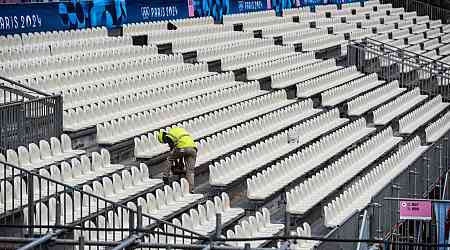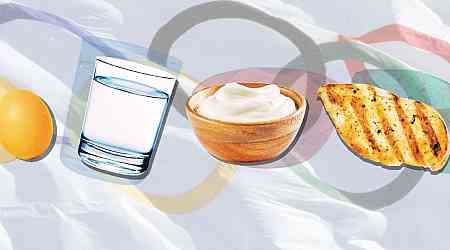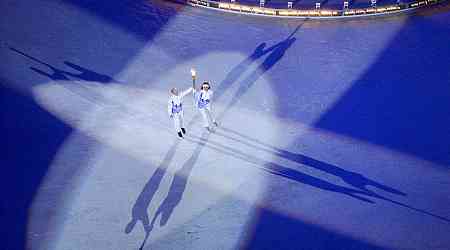
The athletes selected to compete at the most elite level must be extremely regimented to get there. That includes paying close attention to nutrition. We asked eight Olympic athletes—including track-and-field, cycling, and volleyball stars—what they eat to fuel their bodies.
Helen Maroulis
[time-brightcove not-tgx=”true”]
Helen Maroulis is the first U.S. female wrestler to qualify for three Summer Games—and, at 32, the oldest female wrestler to ever compete in an Olympics. Nutrition plays an important role in her success, she says, especially given that she has to make a certain weight (125 pounds) to compete in her class. She’s also had serious brain injuries following concussions she suffered on the mat, and has learned how important the right food choices are for brain health. “My three rules are I have to eat well, I have to sleep well, and training has to be good,” she says. “I don’t compromise on those.”
When Maroulis is in training, she aims to eat about 1,500 calories a day. She could easily eat salads and chocolate for every meal, so she has to be intentional about getting enough protein. For breakfast, she might have a four-egg omelet and some broccolini with ghee, garlic, salt, and pepper. She generally has two snacks a day: sliced apples and almond butter, or a keto sugar-free organic zucchini bread she makes with almond flour. (“It’s on the expensive side,” she says, “but it definitely brings the carbs down.”) If she hasn’t meal-prepped lunch and dinner, she’ll cook a steak and sweet potatoes, or have healthy spring rolls with shrimp. On super busy days, “I’ll just grab a handful of spinach and eat it plain with some eggs and chicken,” she says.
Hydration matters, too: Maroulis usually has a protein shake after a training session, and lately, she’s been craving what her coach calls “healthy Sprite.” She makes it with a SodaStream: “It’s just lemon and some organic fruit sweetener, and it tastes like Sprite,” she says.
Mitchell Saron

Fencer Mitchell Saron, 23, got “super into nutrition” last summer as a way to optimize his athletic performance. He and a handful of friends discovered an “animal-based” style of eating—similar to the keto diet—had blown up on TikTok, so they decided to start following it. They now send each other photos of their daily meals via a group chat that’s grown to include about 15 people.
Saron—who will compete in men’s saber in his first-ever Olympics—focuses on eating grass-fed meat (like beef, lamb, and venison), wild-caught fish, fermented veggies, organic fruit, raw honey and maple syrup, and pasture-raised eggs. He cooks his meals in raw and unsalted grass-fed butter, beef tallow, ghee, or virgin coconut oil. He doesn’t drink alcohol, instead adding salt-based, sugar-free electrolytes to his water. “The biggest change I’ve had is that I think about what my food is eating,” he says. “I don’t want to be eating food that’s at a farm, or in a warehouse, getting fed awful things.” He credits the shift with boosting his energy levels and clearing brain fog. “I just feel great all the time, and I can train longer and harder,” he says.
Read More: Here’s What Alcohol Does to the Gut
Saron doesn’t count calories, but he does keep an eye on protein, aiming for 160 to 180 grams a day. One of his favorite meals is grass-fed rib eye. “I get out a nice wooden cutting board—I like to cut it very pretty,” he says. He’ll dice up mango or kiwi, and have sauerkraut or another fermented veggie, like kimchi, on the side. For dessert, he enjoys grass-fed Greek yogurt, sometimes mixed with grass-fed collagen protein powder. Or he might pair 100% cacao powder with frozen blueberries and raspberries—a tasty dish topped with raw honey and coconut flakes.
Taryn Kloth and Kristen Nuss

Taryn Kloth and Kristen Nuss have been playing beach volleyball together since they were in college—and now, they’re headed to their first Summer Games. Though the Baton Rouge roommates have always taken nutrition seriously, they didn’t go all in until the pandemic hit in 2020, and they suddenly had time to dedicate to tracking their intake and figuring out what their bodies needed. The answer? Lots of protein, carbs, and proper hydration.
Kloth, 27, enjoys starting the day with an English muffin topped with eggs, avocado, and turkey or ham. Breakfast is her favorite meal of the day, so for lunch, she might make an open-face quesadilla with eggs, plus an apple she dips in lactose-free Greek yogurt. (She finds she feels best when she omits lactose.) She has a protein bar before practice if she feels like she needs more fuel, and when she gets home, she chops up Russet potatoes. “I cut them in slices, and then I put them in the oven, and they come out like potato chips,” she says. She’ll probably have another veggie, like roasted cauliflower, on the side, plus some protein. For dessert, she enlists her Ninja CREAMi. “It turns everything into a Dairy Queen frosty,” she says. “I put a protein shake in there”—she likes Core Power’s lactose-free chocolate—“and it turns into ice cream.”
Read More: 8 Eating Habits That Actually Improve Your Sleep
Meanwhile, Nuss, 26, usually has a piece of toast, scrambled eggs, and salsa for breakfast. She also enjoys mixing an avocado with Good Culture 2% Cottage Cheese. For lunch, she’ll dig into a quesadilla with scrambled eggs, avocado, and fat-free cheddar cheese with turkey or ham, plus Greek yogurt mixed with PB2 powdered peanut butter. She enjoys meal-prepping dinners—she gets a lot of ideas from Stealth Health on Instagram—and often has queso chicken mac ‘n cheese made with cottage cheese. For dessert, she can’t resist a Gatsby Sea Salt Extra Dark Bar. “I’ll eat three little squares as a sweet treat, and it’s absolutely delicious,” she says.
Meghan Musnicki

On any given day, rower Meghan Musnicki spends four to six hours on the water or lifting weights in the gym. “Nutrition, and energy in general, is hugely important for our performance,” the four-time Olympian says. “Our bodies are our main tool, so it’s very important for us to make sure we’re giving it what it needs. You wouldn’t put diesel in your gasoline engine and expect it to work.”
Musnicki, 41, doesn’t count calories, but she’s had tests done to measure her resting metabolic rate—which is how many calories she’d need to maintain her weight if she didn’t expend any energy. That number is around 2,000. Once she factors in how much she burns while working out, a dietitian calculated that she has to consume between 3,500 and 4,500 calories per day to maintain her weight.
Read More: How Much Water Should You Drink When It’s Hot Outside?
Most of the time, Musnicki prioritizes nutrient-dense, low-processed foods, like lean protein, fruits, vegetables, and carbs. Though carbs sometimes get a bad rap, they’re a “huge energy source” for endurance athletes, she points out. She also loves chocolate, and when she’s in an intense training cycle, she’ll sometimes reach for a high-calorie treat. “If I need to get in an extra 400 calories, ice cream is not out of the question.”
On training days, Musnicki leaves home at 6:15 a.m. and needs to make sure she has enough fuel to last for two hours. A typical breakfast is oatmeal with fruit, Greek yogurt, pistachios, and honey. “That covers all my bases in terms of carbs, proteins, fats—staying power,” she says. During practice, she’ll have an applesauce packet or a fruit snack for a hit of energy. Once she gets off the water, she has “second breakfast,” which is her favorite meal of the day. She usually opts for an egg sandwich, and perhaps some more yogurt. At lunch, she’ll have grilled chicken breast, vegetables, and rice, and once she heads to her afternoon training session, she’ll down another healthy snack on the water. For dinner, Musnicki enjoys entrees like chicken sausage and chicken breast—or a veggie pizza with red sauce made on her “bougie” wood-fired pizza oven.
Masai Russell

First-time Olympian Masai Russell—who will compete in the 100M hurdles on the U.S.’s track and field team—describes eating well as the most important part of her training regimen. “You can put all the work in, you can get all the rest, but if your body doesn’t have the proper nutrition, it’s not going to be able to operate at its most optimal form,” she says. “I won’t be fueled to do what I need to do at the track if I’m not eating a lot.”
Russell, 24, who talks to a nutritionist every month, starts the day at 8 a.m. with carbs and protein, like two to three eggs, two pieces of bacon, a hash brown, and a green smoothie. That provides the energy dose she needs to feel prepared for the day—and for four hours at the track. Practice usually starts at 1 or 2 pm, and beforehand, Russell has a light lunch, like an acai bowl with fruit, granola, and honey. After practice, she chugs an Evolve plant-based protein shake to make sure she’s maintaining muscle. “I’ve learned that drinking protein shakes post-practice actually helps me to not feel as sore the next day,” she says. Dinner might be a Chipotle bowl or burrito with brown rice, black beans, chicken, corn, light sour cream, light tomato, and a little cheese. If she gets hungry again after that, she’ll have some fruit: “Something sweet, but not candy—something that’s more natural and fresh.”
Russell makes sure to stay hydrated throughout the day, but plain water doesn’t always cut it. Especially when it’s hot outside, she says, it’s essential to get enough electrolytes. “When I’m training, I like to go for a Gatorade for carbs and sugar,” she says. “I also do a sports packet of Pedialyte to keep my muscles hydrated and elastic.” That keeps her feeling healthy and ready to compete.
Josh Kerr

Taking control of his nutrition has helped Josh Kerr unlock “amazing results,” says the middle-distance runner, 26, who competes for Great Britain. He works closely with a nutritionist and chef who design a daily menu for him that prioritizes macronutrients. “It’s probably one of the biggest, last steps I’ve taken into being the athlete I am today,” he says.
Kerr aims for 110 to 140 daily grams of protein, 85 to 100 grams of fat, 350 to 400 grams of carbs pre-workout, and 200 to 300 grams of carbs when he’s recovering from a training session. He starts workout days with gluten-free pancakes, blueberries, raspberries, and plain Greek yogurt, paired with coffee and electrolyte tablets dunked in water. (Kerr is an ambassador for NOW Foods, which makes the tabs.) He undergoes regular sweat testing, which helps his team understand how much salt is in his sweat, and how many electrolytes he needs that day. Having some first thing in the morning is a great way to “kickstart the day,” he’s found.
Read More: 7 Things to Say When Someone Gaslights You
At the start of warm-ups, Kerr might have three CLIF BLOKS Energy Chews—low-calorie cubes that provide a swift dose of energizing carbs. Post-training, when he needs to feed his muscles, he’ll have 25 grams of unflavored whey protein isolate powder mixed into water with 70 grams of electrolyte powder, and then for lunch, a chicken breast sandwich on sourdough bread, topped with half an avocado and two tablespoons of Primal Kitchen mayo. Later, he’ll snack on a beef stick and string cheese, and for dinner, he might dig into barbacoa tacos.
Chloé Dygert

Cyclist Chloé Dygert might not know how many calories she eats every day—but she can tell you exactly what’s on Crumbl Cookies’ weekly menu. “Every Sunday, they put out their flavors for the week,” she says of the gourmet cookie chain. “I always go for the chocolate chip, but they’ve also had Everything Bagel. That was probably my favorite.”
Dygert, who’s doubling up during the Summer Games—she’ll compete in both track cycling and road cycling—jokes that her diet isn’t a great representation of what it takes to excel in the sport. Her friends often tease her: “How can you win, and you don’t eat right?” What she’s doing works for her, she tells them.
The 27-year-old cyclist usually has muesli for breakfast; she fills her bowl with almond milk and lets it soak, and then adds a honeycrisp or pink lady apple, plus a couple scoops of plain Chobani Greek yogurt. If she’s training, she’ll take along a few snacks, like a fig bar, energy gel (carbs in liquid form), or a cookie. Carbs are essential, she notes—she aims for 90 grams per hour of workout. For lunch, she might have a Mexican bowl; for dinner, she’ll wolf down a whole pizza (maybe DiGiorno’s stuffed-crust pie, smothered with cheese and sausage) or a burrito. As an evening snack, she’ll have another plain yogurt, this time paired with granola. The night before a tough workout, she often downs four cookies or 10 Starbucks cake pops. “The next day, I’m on fire,” she says with a laugh.
Read More: What’s the Best Pillow Setup for Sleep?
On race days, Dygert’s meals are scheduled by her team. “They say, ‘OK, the race starts at 1—you guys wake up, have a big breakfast, and then three hours before the race, you’re going to have another little breakfast, so you’re not hungry,’” she says. “Two or three hours beforehand is probably a good benchmark to give yourself enough time to let everything settle.” Afterwards, she guzzles a sugary drink, like a Fanta soda. She also makes it a point to have protein and carbs within 30 minutes to an hour to help her body recover and get a head start on fuel for the next day.
As Dygert heads to the Olympic Village, she’s looking forward to all the different types of food available to athletes: “They have all different cuisines, and a salad bar and fruit bar,” she says. But, as you may have guessed based on her favorite snacks, “What I feel the best on is definitely Mexican and Italian—pizza and rice bowls.” It very well might power her trip back to the podium at this year’s Games.


























